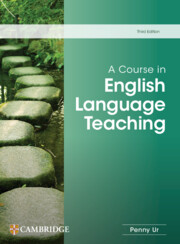Book contents
- Frontmatter
- Contents
- Acknowledgements
- Introduction
- 1 Teaching English today
- 2 The lesson
- 3 Classroom interaction
- 4 Tasks
- 5 Texts
- 6 Teaching vocabulary
- 7 Teaching grammar
- 8 Teaching listening
- 9 Teaching speaking
- 10 Teaching reading
- 11 Teaching writing
- 12 Feedback and error correction
- 13 Assessment and testing
- 14 The syllabus
- 15 Teaching/learning materials
- 16 Teaching content
- 17 Classroom discipline
- 18 Digital technology and online teaching
- 19 Learner differences 1: age
- 20 Learner differences 2: diversity and inclusion
- 21 Teacher development
- Glossary
- References
- Index
- Frontmatter
- Contents
- Acknowledgements
- Introduction
- 1 Teaching English today
- 2 The lesson
- 3 Classroom interaction
- 4 Tasks
- 5 Texts
- 6 Teaching vocabulary
- 7 Teaching grammar
- 8 Teaching listening
- 9 Teaching speaking
- 10 Teaching reading
- 11 Teaching writing
- 12 Feedback and error correction
- 13 Assessment and testing
- 14 The syllabus
- 15 Teaching/learning materials
- 16 Teaching content
- 17 Classroom discipline
- 18 Digital technology and online teaching
- 19 Learner differences 1: age
- 20 Learner differences 2: diversity and inclusion
- 21 Teacher development
- Glossary
- References
- Index
Summary
The first edition of this book, entitled A Course in Language Teaching, was published in 1996, and updated to A Course in English Language Teaching in the 2012 second edition. This third edition includes much of the content of the previous one, but has been extensively rewritten and updated, taking into account recent research and thinking in the field and developments in digital technology, as well as changes in my own thinking.
It retains, however, the same basic rationale underlying the first two editions: that good teaching is that which results in significant learning outcomes. A good teacher is not necessarily someone who is charismatic, or memorable, or loved, or who uses the latest teaching methods. A good teacher is defined first and foremost by results: first, how well their students learn the subject being taught, and second, how motivated they are to learn and continue learning.
The main criterion for my choice of methods or procedures recommended in this book, therefore, is how likely they are, as far as I can judge, to lead to good language learning outcomes and motivation, rather than whether they accord with a particular currently fashionable approach or method.
The book is appropriate for the needs of students in a teacher-preparation course, or for novice teachers in their first year(s) of teaching. It can be used, therefore, as the basis for a trainer-led course, or as a self-study text. Its goal is to equip the beginner teacher with the knowledge and skills needed to perform competently in the classroom: to plan and run interesting and learning-rich lessons, use texts and tasks effectively, and more.
Each chapter is framed by introductory and concluding summaries of content. The introductory Overview gives brief descriptions of the topic(s) treated in each section of the chapter; the concluding Review: Check yourself consists of a list of questions which may be used to help recall of the content of the chapter, and/or to test understanding. Following the review there are annotated suggestions for Further reading, and a References list, which provides details of publications mentioned in the course of the chapter.
- Type
- Chapter
- Information
- A Course in English Language Teaching , pp. 1 - 2Publisher: Cambridge University PressPrint publication year: 2024

